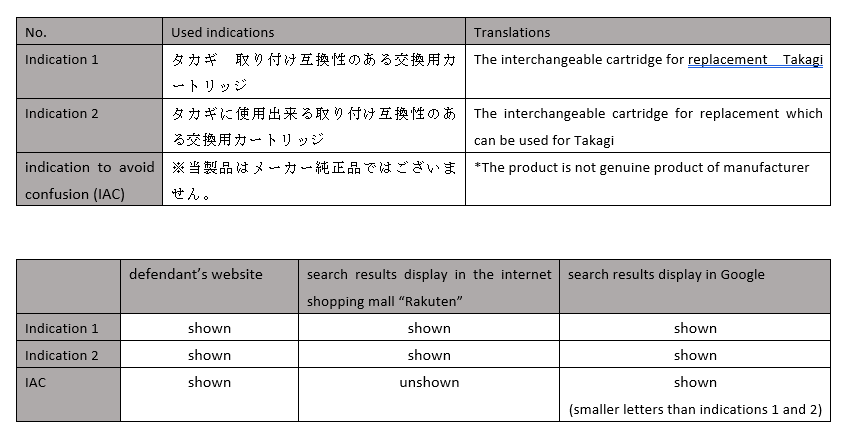2018.12.09
Vol.11 (TAKAGI)
H29 (wa) 14637
Plaintiff’s mark
タカギ (This can be transliterated into “Takagi” and is a general surname)
Goods: Cartridges for water purifying apparatus
Defendant’s mark and other indications

The defendant had used indication 1 and has gotten to use indication 2. When a user clicks indications 1 and 2 of the search results displays in the internet shopping mall or Google, the user links to the defendant’s website.
Conclusion

Summary
The part “タカギ” of indications 1 and 2 should be famous as the plaintiff’s trademark, which is one of the requirements for an infringement under the Unfair Competition Prevention Law. The other requirements are that (1) indications 1 and 2 are used as the indication of source of plaintiff and (2) there is a likelihood of confusion between the plaintiff’s goods and defendant’s goods.
Indication 1
(1) use as the indication of source
Indication 1 should be understood as the indication of source of the plaintiff. The defendant asserted that indication 1 should not be used for indicating the source based on the fact that the indication “The interchangeable cartridge for replacement” of indication 1 and the IAC are shown and that the picture of the product does not indicate the plaintiff’s product. However, this assertion was rejected for the following reasons.
- There is a space between “Takagi” and the other words
- The term “interchangeable” is also used for the goods made and sold by the same company.
- There is a possibility that consumers would not pay attention to all the indications in light of the letter’s size and the nature of the goods.
(2) Likelihood of confusion
If the consumers see the defendant’s website via the search results displays in the internet shopping mall or Google, they may confuse the goods between the plaintiff’s goods and defendant’s goods. This confusion might not be resolved even though the defendant’s website has a notice that the defendant’s product is not the plaintiff’s product. Actually, some consumers who confused the products inquired or complained to the plaintiff. Therefore, there should be a likelihood of confusion of the goods between the plaintiff and the defendant.
Indication 2
Consumers can understand that the defendant’s product is used for Takagi’s product by indication 2, which is the explanation about the content of the product. Therefore, indication 2 should not be recognized as the indication of source for the product. Thus, the use of indication 2 does not fall within the Unfair Competition.
My comments
The court’s judgements varied depending on the difference between indications 1 and 2 in whether they can be recognized as the explanations. In addition, this case teaches us how the indication to avoid confusion (IAC) is shown has influence on the result. In the reason for the judgments, the following fact leads to likelihood of confusion. Even though the IAC was indicated in the defendant’s website where consumers can eventually buy the defendant’s goods, there is a fact that the IAC was not shown in the search result of Rakuten and was shown by smaller letters than indication 1 in the search result display of Google.
Incidentally, the court did not judge about the assertion based on the trademark right of the plaintiff because the assertion has been already accepted based on the Unfair Competition Prevention Law. If the IAC had been conspicuously shown in the search result displays and the defendant’s websites, what conclusion would have been reached? The court might have judged the use of indication 1 not to be infringement based on the requirement “likelihood of confusion” under the Unfair Competition Prevention Law. On the other hand, the use of indication 1 could have infringed the plaintiff’s trademark right because “likelihood of confusion” is not a requirement under the Trademark Law.
CATEGORY
NEW ENTRY



